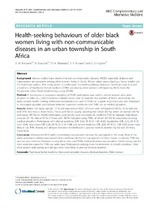| dc.contributor.author | Aboyade, Oluwaseyi | |
| dc.contributor.author | Beauclair, R. | |
| dc.contributor.author | Mbamalu, Oluchi | |
| dc.contributor.author | Puoane, Thandi | |
| dc.contributor.author | Hughes, Gail | |
| dc.date.accessioned | 2017-06-05T08:15:39Z | |
| dc.date.available | 2017-06-05T08:15:39Z | |
| dc.date.issued | 2016 | |
| dc.identifier.citation | Aboyade, O.M. et al. (2016). Health-seeking behaviours of older black women living with non-communicable diseases in an urban township in South Africa. BMC Complementary and Alternative Medicine, 16(1): 410. | en_US |
| dc.identifier.issn | 1472-6882 | |
| dc.identifier.uri | http://hdl.handle.net/10566/2920 | |
| dc.identifier.uri | http://dx.doi.org/10.1186/s12906-016-1378-4 | |
| dc.description.abstract | BACKGROUND: Various studies have shown that non-communicable diseases (NCDs) especially diabetes and
hypertension are prevalent among older women living in South African urban areas, placing a heavy burden on
the healthcare system. This study aimed to understand the health-seeking behaviour, healthcare practices and
prevalence of traditional herbal medicine (THM) use among older women self-reporting NCDs from the
Prospective Urban Rural Epidemiology study (PURE).
METHOD: A homogenous purposive sampling of PURE participants was used to recruit women who were
50 years or older (n = 250). Descriptive statistics were used to examine the number of NCDs reported by the
study sample, health seeking behaviour and practices as well as THM use. Logistic regression was also employed
to investigate possible associations between reported conditions and THM use or medical pluralism.
RESULTS: Within the study sample, 72 % self-reported an NCD. Of those with self-reported NCDs, 46 % had one,
and 54 % had two or more NCDs. Those with NCDs usually visited public clinics (80 %), relied on doctors (90 %)
and nurses (85 %) for health information, and mostly used conventional medicine (CM) to manage high blood
pressure (81 %). About 30 % of those with NCDs indicated using THM, of whom 29 (53 %) reported practicing
medical pluralism. Participants with dental problems (OR: 3.24, 95 % CI: 1.30–8.20), headaches (OR: 2.42, 95 % CI:
1.24–4.94), heart burn (OR: 2.30, 95 % CI: 1.18–4.48) and severe tiredness (OR: 2.05, 95 % CI: 1.08–3.99) were more
likely to use THM. Anxiety and allergies increased the likelihood to practise medical pluralism by five and 20 times,
respectively.
CONCLUSION: Self-reported NCD with co-morbidities was prevalent among the participants in the study. Most of the
study participants utilized state-owned clinics and hospitals for the management of their chronic conditions. THM use
was not very common. However, among those who used THM, medical pluralism was prevalent. Family history was the
most common reason for THM use, with many THM patrons utilizing these for treatment of a health condition. Older
black women with anxiety and allergies were more likely to practise medical pluralism. | en_US |
| dc.language.iso | en | en_US |
| dc.publisher | BioMed Central | en_US |
| dc.rights | © The Author(s). 2016 Open Access This article is distributed under the terms of the Creative Commons Attribution 4.0
International License (http://creativecommons.org/licenses/by/4.0/), which permits unrestricted use, distribution, and
reproduction in any medium, provided you give appropriate credit to the original author(s) and the source, provide a link to
the Creative Commons license, and indicate if changes were made. The Creative Commons Public Domain Dedication waiver
(http://creativecommons.org/publicdomain/zero/1.0/) applies to the data made available in this article, unless otherwise stated. | |
| dc.subject | Medical pluralis | en_US |
| dc.subject | Non-communicable diseases | en_US |
| dc.subject | Older women | en_US |
| dc.subject | Traditional herbal medicine | en_US |
| dc.title | Health-seeking behaviours of older black women living with non-communicable diseases in an urban township in South Africa | en_US |
| dc.type | Article | en_US |
| dc.privacy.showsubmitter | FALSE | |
| dc.status.ispeerreviewed | TRUE | |

